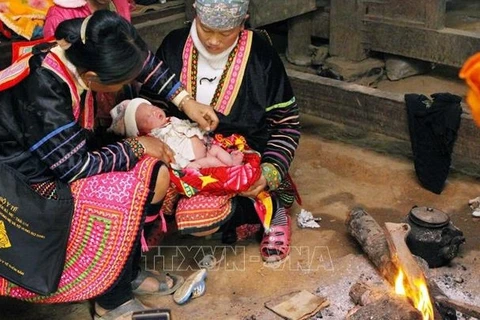Hanoi (VNA) - Vietnamese youths' average height has improved over the past 20 years, as heard at the Ministry of Health's workshop on maternal and child healthcare held in Hanoi on July 28.
According to Tran Dang Khoa, deputy head of the ministry's department of maternal and child health, the average height was 168.1cm for 18-year-old males and 155.6cm for 18-year-old females in 2020, up from 162.3cm and 152.3cm in 2000, respectively.
The average height of Vietnamese people is now ranked 4th in Southeast Asia, behind Singapore, Thailand and Malaysia. However, their rate of height increase in the two decades, compared to countries in Asia like Japan, had yet to reach the desired level, which requires a long process of ensuring such factors as nutrition and micronutrient supplementation.
Khoa said maternal and child health care faces many difficulties and challenges, including the disparity between regions and ethnic groups.
For example, the maternal mortality rate in Region 3 of ethnic minorities is three times higher than in urban areas. The rate in the Mong ethnic group is 7.8 times higher than that of the Kinh and Tay ethnic groups.
The under-1-year-old mortality rate in rural locations is double that in urban areas. In addition, neonatal mortality is still high, accounting for 70-80% of deaths among under-1-year-old infants.
The stunting and underweight malnutrition rate among ethnic minority children is also 2 and 2.5 times higher than that of children from the Kinh ethnic group.
Explaining the reasons for these problems, Dr. Khoa said that a lack of human resources, especially specialists in obstetrics, paediatrics, anesthesiology and resuscitation, is primarily to blame.
The second is the lack of medical facilities and equipment, he stated, in disadvantaged areas, the capacity of medical staff in obstetric and neonatal emergencies, in stages such as screening, diagnosis, and prognosis and treatment, is limited.
He also noted several encouraging records, such as the rate of pregnant women receiving antenatal care at least four times during pregnancy surpassing 80%. In addition, he added that the rate of women giving birth supported by medical staff stood at 95 - 97%, and around 80% receive postpartum care in the first week.
Maternal and child health care has made great strides in recent years, particularly indicators of reducing mortality and child malnutrition rates, the official said, stressing the need to further improve such indicators in the future.
Toward improvement, one of the solutions implemented by the department is to develop a health monitoring book for mothers and children.
This tool, following a Japanese model, was launched in 1998 in the Mekong Delta province of Ben Tre under the sponsorship of the Japan International Cooperation Agency (JICA).
The maternal and child health monitoring books have been deployed nationwide. However, due to the impact of the COVID-19 pandemic, the results are yet to be as expected.
The Ministry of Health issued Decision No. 140 dated January 20, 2020, promulgating a monitoring book for maternal and child health care. This book is scientifically designed according to the progress of pregnancy and child care up to 6 years old. It also contains a lot of useful advice for parents to handle and monitor common problems in children.
More than 40 countries have used the form to promptly detect risks and complications that may be encountered during pregnancy as well as abnormal signs of illness in children./.






















